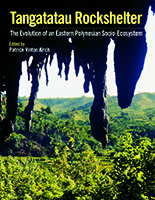Vertebrate faunal remains were systematically recovered from all excavation units and levels by sieving of sediment through nested ½-, ¼-, and ⅛-in. mesh screens. Initial sorting of bone into major categories (fish, mammal, bird, etc.) was carried out by David Steadman, who sent the sorted fish bones to Butler and the mammal bones (except for rat and fruit bat) to Kirch for further analysis. Steadman retained the rat, fruit bat, and bird bones in his laboratory (these specimens are currently housed at the Florida State Museum, Gainesville). A digital database (originally prepared in Paradox and later converted to Excel) of the fruit bat and bird bones, listing each cataloged specimen separately with identification to species and skeletal element, was prepared by Steadman; this database provides the basis for the analysis of fruit bat and bird remains from site MAN-44.
In reporting the vertebrate faunal remains from MAN-44, we use number of identified specimens (NISP) as the primary means of quantification, rather than the minimum number of individuals (MNI). This is due to the high degree of fragmentation of many of the specimens, which renders determination of MNI highly problematic. However, as Grayson (1984) demonstrated, MNI and NISP are in general highly correlated, especially when sample sizes are large. In comparing faunal assemblages from different stratigraphic zones—especially when looking at overall temporal trends—we also use concentration indices (CIs) calculated as NISP per cubic meter of deposit, which provides a sample size correction for the different volumes of sediment excavated in each stratigraphic zone.
